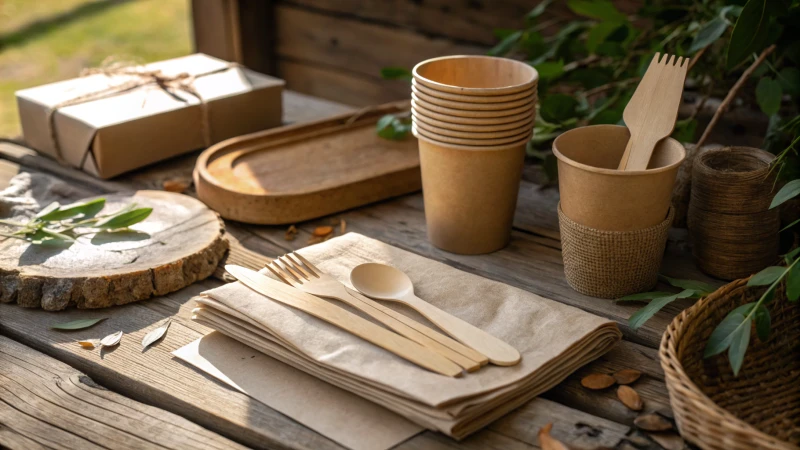
Ever wondered how disposable wooden cutlery is getting a green makeover?
Disposable wooden cutlery is now being paired with eco-friendly packaging using materials like biodegradable plastics and plant-based alternatives. These sustainable options not only lessen environmental impact but also meet consumer demand for greener products.
I remember the first time I saw a biodegradable fork; it was in a quaint little café, the kind that makes you feel at home. The owner told me how excited she was to switch to eco-friendly options, sharing that her customers were thrilled too. This shift is more than just a nod to Mother Earth; it's a response to the growing demand for sustainable practices. Brands are creatively incorporating green materials like biodegradable plastics and plant-based alternatives into their packaging. It’s fascinating to see how these innovations not only reduce our carbon footprint but also elevate the dining experience by aligning with what consumers truly care about—our planet's well-being.
Biodegradable plastics are used in eco-friendly cutlery packaging.True
Biodegradable plastics are increasingly used to reduce environmental impact.
All wooden cutlery packaging is plant-based.False
Not all packaging uses plant-based materials; some still use traditional plastics.
Why Is Eco-Friendly Packaging Important for Your Business?
I remember the moment I realized my business needed to go green—it was like turning on a light in a dark room. Eco-friendly packaging isn't just about saving the planet; it's about meeting today's consumer expectations and staying ahead in the game.
Eco-friendly packaging is essential for businesses because it minimizes environmental impact, satisfies consumer demands for sustainability, and boosts brand reputation. It often leads to cost savings and aligns with global regulatory standards, paving the way for long-term success.
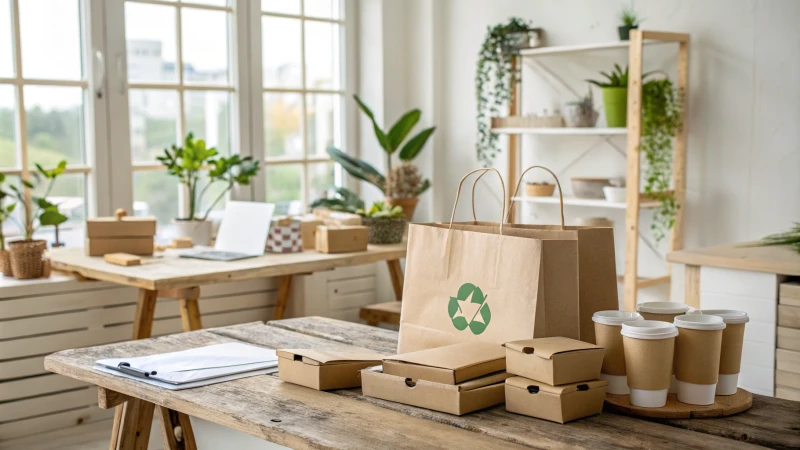
Enhancing Brand Image and Consumer Trust
I’ve seen firsthand how eco-friendly packaging can transform a brand. Think about it: today’s consumers are more aware than ever of their environmental footprint. Imagine walking into a store and choosing between two products—one wrapped in excessive plastic and the other in sleek, biodegradable materials. Which would you pick? A recent study even pointed out that 70% of consumers are more likely to buy products with sustainable packaging. By switching to eco-friendly options, not only have I noticed an uptick in sales, but I've also earned the loyalty of eco-conscious customers.
Economic Advantages of Sustainable Packaging
When I first considered the shift to sustainable packaging, the initial costs seemed daunting. But here's the secret I discovered: over time, those costs pay off. By reducing waste and improving efficiency, I've managed to cut down on expenses significantly. And let's not forget the perks—like reduced disposal costs when using biodegradable materials1 and tapping into tax incentives. It’s been a journey of savings, not spending.
Compliance with Regulatory Standards
Navigating the maze of global regulations can be overwhelming, but embracing eco-friendly packaging has helped me stay ahead. Many countries are tightening their packaging waste laws, and being proactive means avoiding fines and gaining a competitive edge. Understanding these regulations2 is crucial for any business aiming to thrive in this evolving landscape.
Innovative Materials and Solutions
I love exploring new materials that push the boundaries of traditional packaging. Plant-based plastics, recycled paper—you name it, I've tried it. Following in the footsteps of giants like Coca-Cola and Unilever has been inspiring, and experimenting with these innovations3 has allowed me to create unique strategies that resonate with my environmentally-conscious audience.
A Table of Eco-Friendly Packaging Materials
| Material | Benefits | Examples |
|---|---|---|
| Biodegradable Plastics | Reduced landfill waste | PLA, PHA |
| Recycled Paper | Minimal energy consumption | Cardboard |
| Plant-Based Materials | Renewable sources | Cornstarch packaging |
Incorporating eco-friendly packaging is more than a market trend—it’s an essential strategy for long-term success. By prioritizing sustainable practices, I've not only contributed to preserving our environment but also positioned my business as a leader in a rapidly evolving market.
70% of consumers prefer sustainable packaging.True
A study showed 70% of consumers favor products with eco-friendly packaging.
Eco-friendly packaging increases disposal costs.False
Switching to biodegradable materials can reduce disposal costs significantly.
What Innovative Materials Are Leading the Eco-Friendly Packaging Revolution?
Ever wondered what’s behind the buzz of eco-friendly packaging? Let's dive into the innovative materials reshaping this crucial industry.
Leading the eco-friendly packaging revolution are materials like biodegradable plastics, plant-based packaging, and recycled paper. These materials reduce waste and environmental impact, aligning with sustainable practices in various industries.
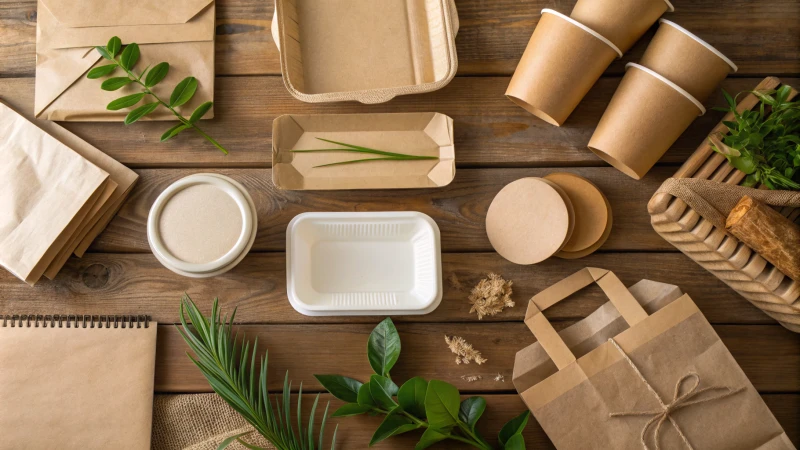
Biodegradable Plastics: A Green Alternative
Imagine opening a package that looks and feels like plastic but won’t linger in a landfill for centuries. That’s the magic of biodegradable plastics. Derived from natural sources like corn starch or sugarcane, these materials decompose naturally, leaving no harmful residues. I remember the first time I came across a biodegradable plastic bag at a local farmer's market—it felt like holding a glimpse of the future. More companies are embracing these biodegradable solutions4 to align with the growing consumer demand for sustainability.
Plant-Based Packaging: Harnessing Nature's Power
Plant-based packaging is another trailblazer in this revolution. Using renewable resources like bamboo and mushrooms, it offers durable and compostable alternatives. I once attended a conference where they handed out bamboo-based water bottles, and I was amazed by how sturdy yet eco-friendly they felt. This innovation reduces reliance on fossil fuels and finds applications from food to cosmetics.
Recycled Paper: The Traditional Favorite
Recycled paper might seem old school, but it's still a champion in eco-friendly packaging. It uses less energy during production compared to virgin paper and supports the circular economy5 by reintroducing materials into the supply chain. I’ve always appreciated how recycled paper feels—it’s like holding a piece of history that’s been given new life.
| Material | Source | Benefits |
|---|---|---|
| Biodegradable Plastics | Corn, Sugarcane | Reduces landfill waste, lowers carbon footprint |
| Plant-Based Packaging | Bamboo, Mushrooms | Renewable, compostable |
| Recycled Paper | Post-consumer waste | Supports circular economy |
Innovations in the Industry
Beyond just materials, the industry is bursting with creativity in design and functionality. Some brands are using water-soluble films that dissolve after use, creating minimal waste. Others explore algae-based solutions6, showcasing versatility in sourcing raw materials. I can’t help but be excited about these advancements—they represent a shift towards a sustainable future where our packaging protects both products and our planet.
For more insights into how these materials are changing industries, check out our section on sustainable packaging trends7. Embracing these innovations could be a small yet significant step towards a greener tomorrow.
Biodegradable plastics are made from corn starch.True
Biodegradable plastics can be derived from natural sources like corn starch.
Recycled paper does not support the circular economy.False
Recycled paper supports the circular economy by reintroducing materials.
How are major brands successfully implementing eco-friendly packaging?
Imagine opening a beautifully designed package and realizing it's also eco-friendly—talk about a win-win!
Major brands are achieving eco-friendly packaging success by using biodegradable materials, optimizing designs to minimize waste, and leveraging technology to track and enhance sustainability metrics, all while aligning with the growing consumer demand for sustainable products.
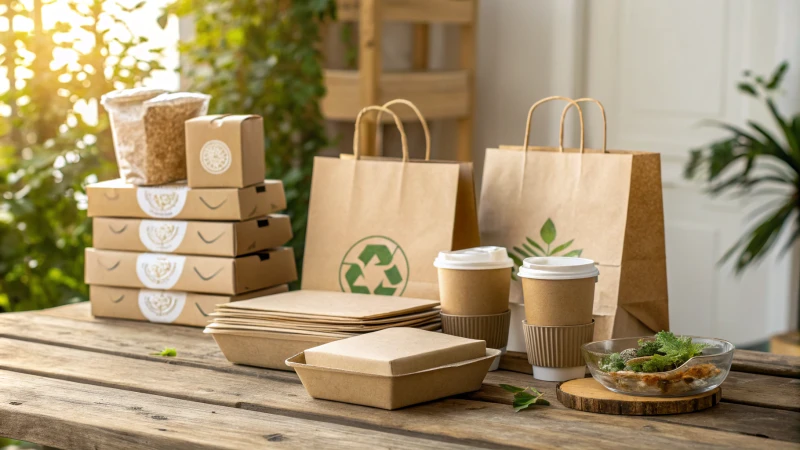
Biodegradable Materials: A Game Changer
I remember the first time I picked up a product with eco-friendly packaging. It was a simple bar of soap from a popular brand, but the moment I felt the biodegradable material in my hands, I knew this was something special. Brands like Coca-Cola and Unilever are leading the way by using biodegradable materials, such as plant-based plastics and compostable paper, which break down naturally and don't leave behind harmful residues. These innovations not only cut down on waste but also inspire consumers like me to think more about recycling.
Biodegradable plastics8 offer a renewable alternative to traditional packaging, breaking down naturally without leaving harmful residues. These innovations not only reduce waste but also encourage consumers to embrace recycling.
Optimized Design for Minimal Waste
In the fashion world, companies like H&M are making strides by integrating recycled materials9 into their packaging. By designing packages that use less material and are easier to recycle, they're not just reducing their carbon footprint—they're setting an example for us all. Smaller, reusable packaging options also play a part in creating a more sustainable lifecycle for products.
Leveraging Technology for Sustainable Practices
Technology is another powerful ally in this journey. Brands are increasingly using tech, like blockchain technology10, to track their supply chains' sustainability in real-time. This transparency ensures accountability and allows consumers to see the environmental impact of their purchases firsthand.
This digital transformation aids in achieving higher standards of sustainability compliance and offers consumers insight into the environmental impact of their purchases.
Embracing Consumer Trends
Moreover, the shift in consumer trends towards environmentally responsible products is undeniable. Eco-friendly packaging not only meets sustainability trends11 but also builds brand loyalty among eco-conscious consumers, driving both value and sales growth.
The demand for environmentally responsible products is reshaping how brands approach packaging.
| Brand | Material Used | Innovative Approach |
|---|---|---|
| Coca-Cola | Plant-based plastics | Fully biodegradable bottles |
| Unilever | Compostable paper | Plastic-free packaging lines |
| H&M | Recycled textiles | Reduced packaging size |
| Lush | Naked packaging | Package-free products |
Strategic Partnerships for Greater Impact
Partnerships are crucial too. Brands like PepsiCo are working with TerraCycle to develop closed-loop systems that reduce waste12 and promote circular economies. These collaborations not only spark innovation but amplify the reach of eco-friendly initiatives across industries. It's inspiring to see how collective efforts can lead to significant change.
Coca-Cola uses fully biodegradable bottles.True
Coca-Cola is pioneering plant-based plastics, creating biodegradable bottles.
H&M uses blockchain to track packaging sustainability.False
H&M focuses on recycled materials, not blockchain for tracking sustainability.
What Future Trends Should You Watch in Eco-Friendly Packaging for Wooden Cutlery?
Ever wondered how eco-friendly packaging is transforming the way we use wooden cutlery? Join me as we dive into the trends shaping this sustainable shift.
Future trends in eco-friendly packaging for wooden cutlery include biodegradable materials, innovative designs, and smart solutions that minimize waste while boosting sustainability.
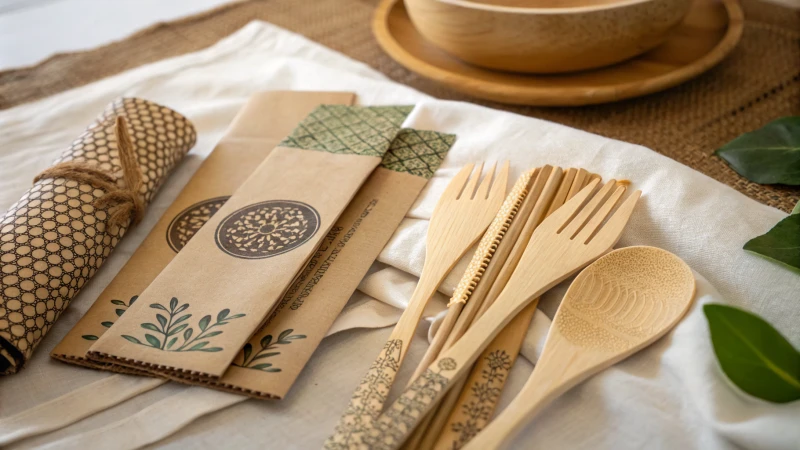
I remember when I first started exploring sustainable alternatives for my business. The excitement of finding new, eco-friendly solutions was invigorating, and each discovery felt like a step towards a greener planet. Today, let's explore some of the exciting trends in eco-friendly packaging for wooden cutlery.
Biodegradable Materials
Imagine holding a spoon made from corn starch or even algae! That's where we're heading with biodegradable materials13. As more of us become environmentally conscious, the demand for materials that break down naturally is soaring. Brands are tapping into creative solutions like corn starch, bagasse, and algae-based materials. These not only reduce our carbon footprint but also help us leave a cleaner planet for future generations.
Innovative Design
Innovative design is another fascinating trend. Have you ever seen packaging that fits together like puzzle pieces? It's not just cool—it saves space and reduces waste! Smart labeling systems are also on the rise, guiding us on how to recycle or compost each item. This kind of design doesn't just enhance functionality; it makes sustainability feel exciting and accessible.
Smart Packaging Solutions
Technology is seeping into our packaging, and I find this absolutely thrilling. With QR codes, consumers can now learn how to dispose of or recycle products responsibly. And edible packaging14? Yes, it’s a thing! Imagine nibbling away at your plate once you’ve finished your meal—zero waste at its finest.
Consumer-Driven Changes
We're all part of this green revolution, driving demand for transparency and sustainable practices. I’ve noticed how much more informed we’ve become as consumers, wanting to know the complete lifecycle of products. Brands are responding by adopting transparent practices, ensuring we know where our products come from and how they should be disposed of.
| Feature | Benefits |
|---|---|
| Biodegradable Materials | Reduces landfill waste and environmental pollution by breaking down naturally. |
| Innovative Design | Optimizes space and reduces material usage; enhances consumer engagement through aesthetic appeal. |
| Smart Packaging | Provides consumers with easy access to sustainability information; reduces confusion around recycling and disposal. |
These trends aren’t just reshaping the packaging industry—they're part of a broader movement towards sustainability. As we continue to demand eco-friendly options, it's exciting to see how quickly the industry is adapting to meet these needs.
Biodegradable materials are harmful to ecosystems.False
Biodegradable materials break down naturally, minimizing environmental harm.
Smart packaging can include QR codes for recycling info.True
QR codes on packaging guide consumers on proper disposal methods.
Conclusion
Eco-friendly packaging trends for disposable wooden cutlery include biodegradable materials, innovative designs, and smart solutions that enhance sustainability while meeting consumer demand for greener products.
-
Learn about the financial advantages of using biodegradable materials, including potential cost savings and incentives. ↩
-
Find detailed information on global packaging regulations to ensure compliance and avoid legal issues. ↩
-
Discover cutting-edge materials that are shaping the future of sustainable packaging solutions. ↩
-
Discover how biodegradable plastics minimize environmental impact while maintaining functional properties. ↩
-
Explore how recycled paper contributes to sustainability and supports eco-friendly business practices. ↩
-
Learn about the versatility and environmental benefits of algae-based packaging innovations. ↩
-
Stay updated with emerging trends that are shaping sustainable packaging solutions. ↩
-
Learn about biodegradable plastics and their role in reducing environmental impact through sustainable packaging. ↩
-
Discover H&M's strategies in utilizing recycled materials to promote sustainability in fashion. ↩
-
Explore how blockchain technology enhances supply chain transparency and sustainability tracking. ↩
-
Stay updated on the latest trends driving sustainable practices in consumer goods. ↩
-
Understand TerraCycle's role in creating closed-loop systems for minimizing waste. ↩
-
Explore innovative biodegradable materials making waves in sustainable packaging. ↩
-
Learn about cutting-edge edible packaging that eliminates waste entirely. ↩

